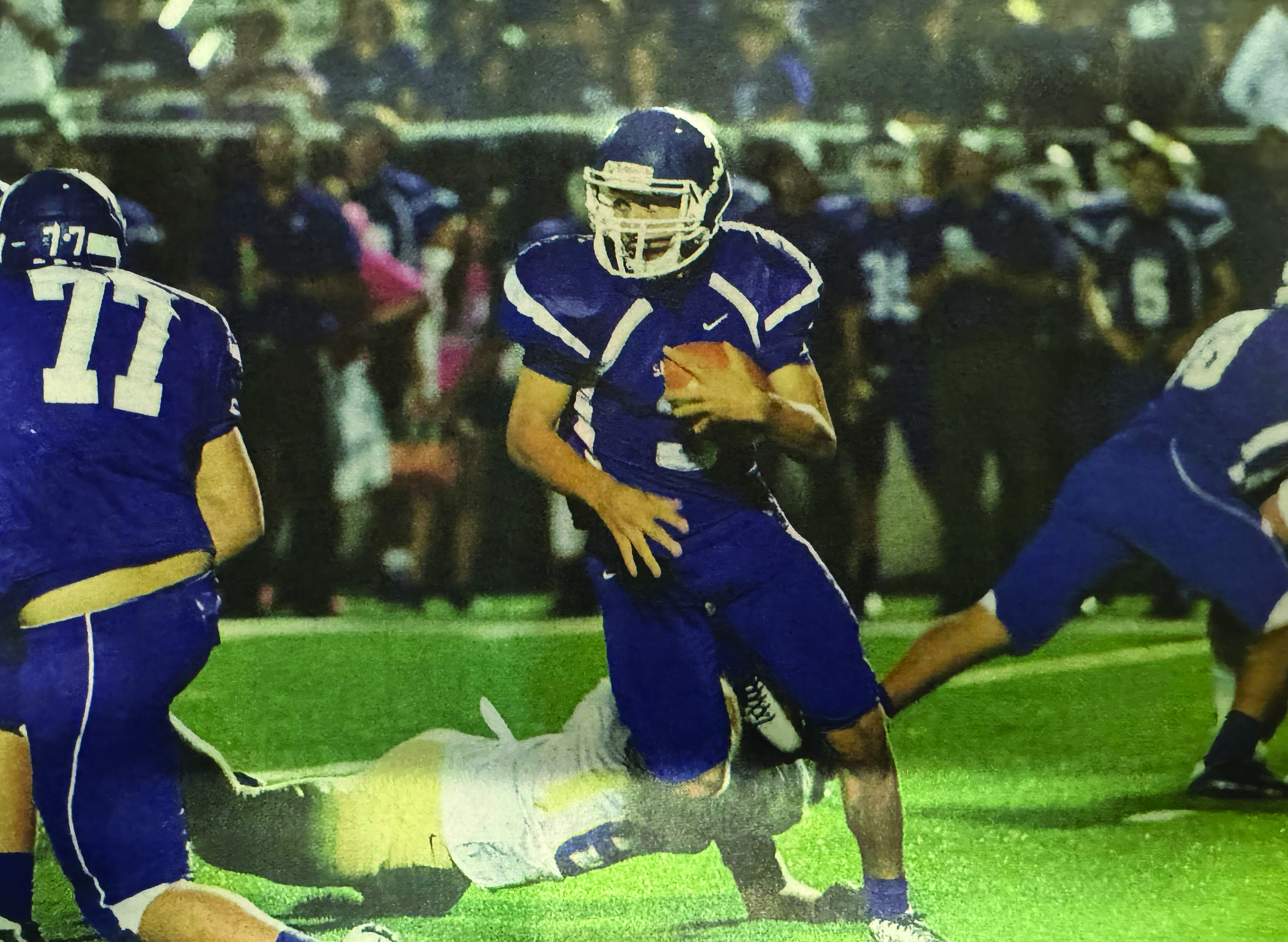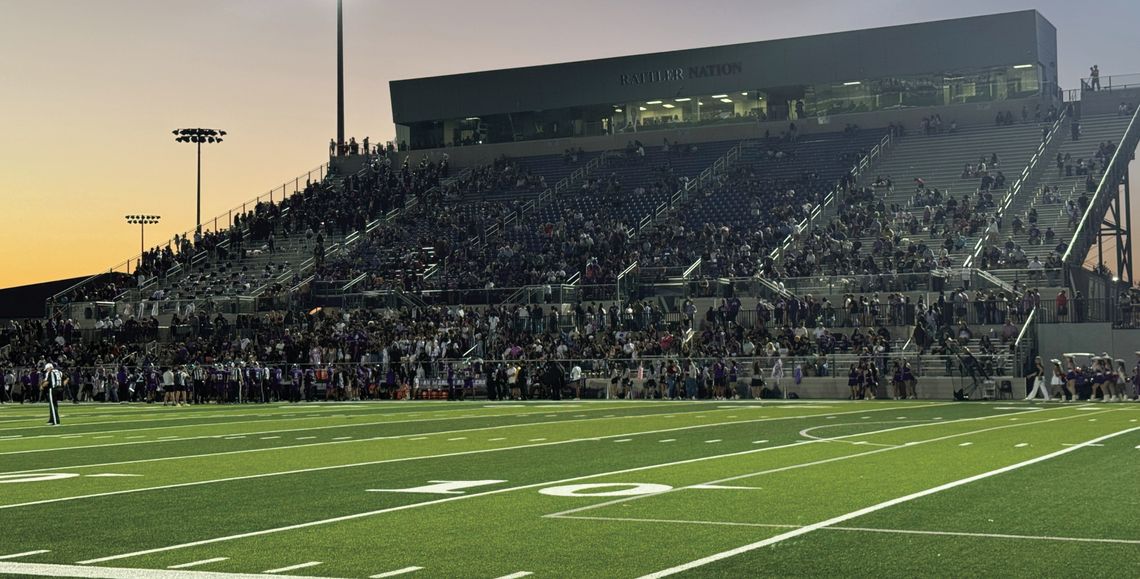SMHS FOOTBALL
Toyota Rattler Stadium turns 10 years old
For the current generation of Rattler athletes, Toyota Rattler Stadium has been home. But past generations did not have that luxury.
The lack of a home stadium is something that shocked longtime San Marcos Daily Record Sports Editor and stadium PA Announcer Randy Stevens when he first arrived in San Marcos in 1996.
“I remember when I first got here, I was amazed [San Marcos] didn’t have their own stadium,” Stevens said. “When I was in high school, your field was right by the high school, so you went to the locker room straight in. But here, everyone had to bus over to [UFCU] Stadium. It never felt like it was theirs.”
Since playing football, the Rattlers often shared with the Texas State Bobcats, playing at old Evans Field then UFCU Stadium, formerly known as Bobcat Stadium.
But it all changed in 2014 when a bond was passed to begin the construction of Toyota Rattler Stadium, which now celebrates the ten year anniversary of its granding opening.
“When we got Rattler Stadium, we were the biggest school that did not have a stadium,” Stevens said. “It was worth it. … It is all for the kids and the student athletes. It’s been a big boost.”
The movement for San Marcos High School to build Toyota Rattler Stadium started to take shape due to a number of factors.
As Ishmael Johnson, former San Marcos Daily Record sports editor and Dave Campbell’s Texas Basketball Magazine managing editor, explained, a growing population in San Marcos and a reinvestment towards Rattler athletics were key to the stadium's development.
“It was kinda a thing when you wondered if this was actually going to happen,” Johnson said. “They were paying Texas State, and the [school] district eventually had to see a need. The problem was that San Marcos was [and still] is a rising, continuously growing city. The situation was that San Marcos was in 5A and about to go to 6A, so how big the stadium needed to be [was a point of contention]. When it comes to anything football related, there is multi-uses and purpose[s].”
Along with the building of the stadium, San Marcos also saw the opportunity to upgrade their other facilities as well.
“When [Mark Soto] was hired, there was an effort to upgrade everything athletically with the program,” Johnson said. “Obviously the stadium was the big thing, but at the same time, the baseball and softball stadiums got new turf. Then the following year came the indoor facility. That whole calendar year felt like a huge moment because… the football stadium getting done was a massive moment, but it also signifies San Marcos as [a] whole reinvesting into athletics.”
But life at Bobcat Stadium was not without positive memories.
From the late 90s to early 2000s, the Rattlers became a powerhouse winning district championships and going on long playoff runs while outdrawing the Bobcats in their own stadium.
One of the most famous Rattler games to be played at Bobcat Stadium came in 1998 when San Marcos hosted archrival Hays in front of an estimated 16,300 fans in attendance. Then in 1999 where the Rattlers defeated Kerrville Tivy for San Marcos’ first playoff since 1966.
“Before [UFCU] Stadium was expanded and the Rattlers were winning a lot, it was common to see bigger crowds there than at the Bobcat football games,” Stevens said. “But when the stadium was expanded and the university moved up to FBS, it started to feel a little bit cavernous. Then of course the lease they would have to pay was going to be crazy.”
The journey to the first ever football game at Toyota Rattler Stadium was not without its hiccups. During the summer, above average rainfall dropped on San Marcos and forced the construction to be delayed.
The much hyped game was pushed to Oct. 17 when the Rattlers were already done with the half of the season.
“That summer had a lot of rain, so there was a lot of delay [in construction],” Johnson said. “It was on track, but there was so much rain that it created a little bit of a hiccup. … It did hurt the momentum a little bit because everyone had to wait essentially the whole month and had to play more games at Texas State.”
With the 2014 home games against both Seguin and Alamo Heights being moved to UFCU Stadium, the glaring problems of not having their own stadium were now exemplified.
“The problem was that everyone knew that it wasn't their home,” Johnson said. “It’s a 28,000 to 30,000 plus stadium, and they were a team that was struggling at the time. so they couldn’t fill it out. It felt weird because it was like you were at a neutral stadium, and that is how many in the program felt.”
After a long delay, the Rattlers finally played their first home game at Toyota Rattler Stadium in front of over 5,000 fans in attendance.
As Johnson explained, it was a long time coming.
“You could tell based on the hype, the build up and the surrounding environment, it was a moment everyone was waiting for,” Johnson said. “The stadium was one of a kind [during that time]. Very few people had that stadium built. The stadium and the video board were unique [including] the fact students were able to work the entire production.
“It was a culmination of the city feeling a sense of pride. The team had a losing record but it didn’t matter. The stadium was packed.”
The Rattlers later hosted Boerne Champion as the momentum carried on from the Kerrville Tivy game.
“Champion was state ranked, and San Marcos had a losing record. But it didn’t matter,” Johnson said. “People just wanted to go to that game, and it was right off campus. You didn’t have to drive into San Marcos and through Texas State. It was right there.”
After covering the Rattlers for so long, it was a long time coming for Stevens to see San Marcos High School to have a place to call home.
“It finally felt like it was Class [6A] football,” Stevens said. “We had a stadium that could matchup with the best of them. … It was completely packed. On the visiting side, it was filled with Rattler fans because everyone wanted to be out and see the stadium.”
Toyota Rattler Stadium is now seen as a crown jewel of Texas High School stadiums and is the site not just of Rattler football games but also high profiled playoff games as well.
“It justifies it,” Johnson said. “It is a destination spot. A lot of people have that [stadium] model now, but it’s still a nice stadium. That doesn’t diminish its quality. I still love the fact you can see from the highway and the SM logo in the distance. It shows they were right to put the investment in.”
It is every Texas High School football player’s dream to play in front of the home crowd they represent. Now the current generation of Rattler athletes are able to fulfill that dream.
“Growing up in Manor, I wanted to play in Manor Stadium,” Johnson said. “It’s different to see a home crowd packed out for a home opener, a playoff game, rivalry game or homecoming, but it gets drowned out by a stadium that is not three-quarters full. There is a sense of pride seeing the stadium decked out in purple, the home side packed [and] the video board looking incredible. It’s a sense of familiarity.”
cmcwilliams @sanmarcosrecord.com Twitter: @ColtonBMc








